- Introduction
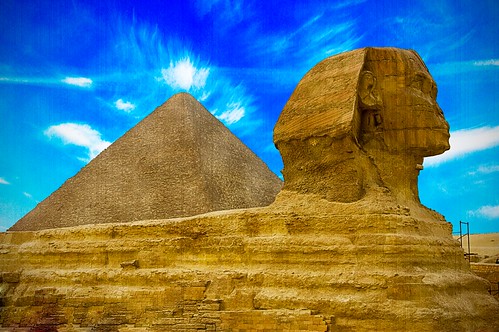 Along with the Great Pyramid of Giza, the Sphinx is one of the greatest enigmas and the most studied ancient monument of mankind’s history. The whole complex of Giza, composed of the Sphinx, the Great Pyramid, other pyramids, and distinct structures, definitely holds the key to understanding advanced past civilizations. There is no other place teeming with so many researchers looking into the mysteries of mankind’s past, which may cause history to be rewritten.
Along with the Great Pyramid of Giza, the Sphinx is one of the greatest enigmas and the most studied ancient monument of mankind’s history. The whole complex of Giza, composed of the Sphinx, the Great Pyramid, other pyramids, and distinct structures, definitely holds the key to understanding advanced past civilizations. There is no other place teeming with so many researchers looking into the mysteries of mankind’s past, which may cause history to be rewritten.In the examination of the mystery of the great Sphinx we run into a similar situation. The Egyptians wrote very little about the construction of the Sphinx. However, the Egyptians, Romans, and Arabs did write accounts concerning its numerous restorations, which will be discussed later in this article. In addition, it should be said that other cultures had their form of a Sphinx. For example, the Greek Sphinx was female with a human head, breasts, and the body of a feminine lion.
- What theories exist on the Sphinx?
Now there are basically two schools of thoughts concerning the origin, age, and the builder of the Sphinx in Egypt. The established group are Egyptologists who believe that Pharaoh Khafre built the Sphinx around 2500 B.C., which is about the 4th dynasty. This theory makes the Sphinx about 5,000 years old according to Dr. Zahi Hawass, Director of Giza Saqqara of the Egyptian Antiquities Organization (p. 348) as stated in Graham Hancock’s book Fingerprints of the Gods (© 1995 Crown Trade Paperbacks).
Now the other school of thought does not believe that the Egyptians built the Sphinx, but think that it was built by an advanced civilization 8,000 to 10,000 B.C. This school of thought has been around for hundreds of years, but new findings give it more credibility. Recently, Graham Hancock, John West, an American scholar, Robert Bauval, and others have presented certain evidence that challenges the traditional thoughts about the Sphinx and the whole Giza complex.
They present proof that may cause a rethinking of the model used to determine who built the Sphinx and the Great Pyramid and for what purpose. Their proofs consist of basically two pieces of evidence. First the geological indications that the Sphinx’s erosion was due to water rather than wind/sand making it much older than previously thought, according to the book Fingerprint of the Gods. Second, astronomical alignments show that the Sphinx was clearly an equinoctial marker facing east, which identifies the exact position on the horizon that the sun dawns on the spring equinox (1st day of spring) according to Graham Hancock’s and Robert Bauval’s book The Message of the Sphinx (p. 59).
Many of the legends of the Egyptians and Arabs support this position. They believe that an advanced civilization prior to the flood (i.e., in the Ante-Diluvian Age) built these structures which will be discussed later in this article.
These new findings imply that mankind’s history is older than the 6,000 years of Christian tradition and an advanced ancient civilization built the Sphinx. This would mean that history would have to be rewritten or a better understanding of Moses account of creation.
Now Graham Hancock quotes John West’s view on the orthodox view of mankind’s history. "We are told that the evolution of human civilization is a linear process-that it goes from stupid cave man to smart old us with our hydrogen bombs and striped toothpaste. But the proof is the Sphinx…means that there must have been, … high and sophisticated civilization-just as legends affirms (p. 358)."
- What is the intent of this article?
Now the intent of this article is to briefly investigate the old and new theories about the origin, purpose, and builders of Sphinx. It will also explore the implications of these new findings.
This article will show also the reality of the Sphinx using the Bible and the Tabernacle for the Sphinx also appears to have close similarities to the creatures seen by Ezekiel and the Apostle John in their visions.
- What are the form and dimensions of the Sphinx?
Now no one knows how the Sphinx looked at its completion because both natural erosion and destruction at the hand of man have altered its original form. Archeologists and historians found many pictures of the Sphinx drawn with wings, the body of a lion and ox, and the face of man. Today only the face of a man and body of a lion are apparent on the Great Sphinx.
Now the Sphinx faces east or the raising sun. Many Egyptologists overlooked this simple fact, which will play a major part in identifying its purpose.
The Sphinx was carved out of a single piece of stone weighing hundreds of tons. It is over 200 feet in length or about as long as a city block. According to Manly P. Hall’s book The Secret Teachings of the Ages (p. XLII), the Sphinx is about 70 feet in height and is 38 feet across the shoulders. Now no one knows what types of tools were used to carve the stone.
- What observations of the Sphinx have been made in the present and past?
 Those observing the Sphinx first hand are in awe of it. It seems to radiate that it is thousands of years old and has withstood the ages of time. There is also something very mystical about it that tends to convey to the observer that there is something metaphysical or spiritual about it.
Those observing the Sphinx first hand are in awe of it. It seems to radiate that it is thousands of years old and has withstood the ages of time. There is also something very mystical about it that tends to convey to the observer that there is something metaphysical or spiritual about it.According to Manly Hall, for thousands of years, the Sphinx had been a symbol of strength and intelligence to the Egyptian culture. The ancients also thought that it portrayed an androgynous being showing that all partakes of the positive and negative powers of the Gods. Most Egyptologists confirmed this belief.
- What inscriptions are on the Sphinx?
Although there are no records regarding the construction of the Sphinx, there are records of its restoration. The "Sphinx Stela," a stone-engraved inscription dated around 1400 B.C., is the oldest record concerning the Sphinx. According to Fingerprints of the Gods, it describes the restoration of the Sphinx by Pharaoh Thutmosis IV (1401-1391 B.C.) of the 18th Dynasty.
The Stela states that during a hunting trip Prince Thutmosis became tired and slept in the shadow of the Sphinx. He had a dream that the Sphinx promised to reward him with a double crown of Egypt if he would remove the sand from it and restore the sculpture.
According to Manly Hall’s book and Max Thoth book Pyramid Prophecies (p. 158), another account of this legend states that the god appeared unto Prince Thutmosis asking him to do the same. Due to erosion of the stela inscription, no one knows how this promised was fulfilled.
Basically, this granite inscription described the form of the Sphinx as a lion’s body. It also stated that the embodiment was "a great magical power that existed in this place from the beginning of all time (p. 11)," according to the book The Message of the Sphinx by Graham Hancock and Robert Bauval (© 1996 Three Rivers Press).
Now this stone inscription did not explain the purpose, the original designer and builder, or the date of the Sphinx’s erection. However, it did cause a great controversy. On line 13 of the inscription it contains the first syllable "Khaf" and it has been associated with King Khafre of the Fourth Dynasty of Pharaoh, who reigned during 2520-2494 B.C.
From this inscription the orthodox view found in any textbook and encyclopedia states that King Khafre built the Sphinx. It will be shown later that a minority group does not accept this view.
Since the Sphinx is located in a desert region, the sand constantly recovered it. In the last 200 years the Sphinx has been excavated and re-excavated four or five times. Basically, this has been the history of the Sphinx.
- Are there other historical views of the Sphinx?
Graham Hancock’s book describes the modern Egyptologist’s view that Pharaoh Khafre built the Sphinx and other monuments, which would make them only 100 years old. Before this, the common view was that the Sphinx and the other monuments of the Giza were built by an advanced antediluvian civilization that was destroyed by the flood.
Many 19th and 20th century researchers supported this. The late Wallis Budge, authors of many books on ancient Egypt, and Keeper of the Egyptian Antiquities at the British Museum, believed that the Sphinx was much older than Egypt. Hancock makes the following quotes: "The Sphinx was thought to be connected in some way with foreigners or with a foreign religion, which dated from predynastic (p. 347)."
The Romans and Arabs believed this view. Now the book The Message of the Sphinx verifies this. It states that Roman Armmianus Marcellinus directed treasure hunters to look for books and scrolls in the Sphinx’s repository. They believed that records of this civilization were stored to "prevent the ancient wisdom from being lost in the flood of past age (p. 85)." Arab records of the 9th century also confirm this view.
- What did Edgar Cayce say about the "Hall of Records"?
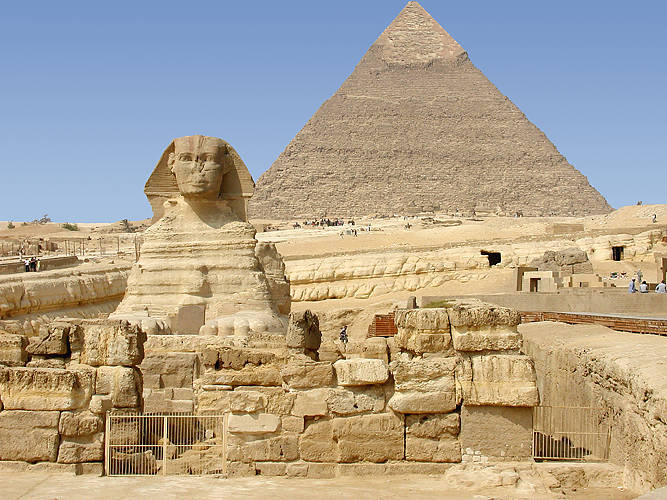 Now Edgar Cayce (1877-1945) has been called the sleeping prophet. Cayce had the ability to put himself into a deep trance. This allowed him to diagnose various physical illnesses and reveal a treatment. While in these deep trances, Cayce also spoke of Atlantis, the Sphinx, and Egypt.
Now Edgar Cayce (1877-1945) has been called the sleeping prophet. Cayce had the ability to put himself into a deep trance. This allowed him to diagnose various physical illnesses and reveal a treatment. While in these deep trances, Cayce also spoke of Atlantis, the Sphinx, and Egypt.He stated in some of his trances that Egypt was the repository for records of the alleged civilization of Atlantis, about 10,500 B.C. This repository was an underground library, called the Hall of Records," that contains the wisdom of Atlantis. Cayce said that during this period this was the first attempt to restore and add to the Sphinx.
Cayce claims that the Sphinx points in the direction of the "Hall of Records." His reading states: "There is a chamber or passage from the right forepaw of the [Sphinx] to this entrance of the Hall of records, or chamber," as quoted by Graham Hancock Many of his followers believe this chamber will be found before the end of the 20th century.
Now in the 1980’s and 1990’s the Edgar Cayce Foundation conducted quite a bit of research in Egypt around the Sphinx to verify Cayce’s reading. Although researchers from all over the world have begun to look for this chamber with very sophisticated instruments, they have not found the Hall of Records."
- Are there any Biblical references of Antediluvian civilizations and monuments?
In the book of Genesis in the Old Testament there is no reference to the Sphinx or any other monuments that antediluvian civilizations built. In fact, there is very little written in Genesis on how far mankind’s technology advanced in this age. The seed of Cain was described as craftsmen of iron and brass (Gen. 4:17-22). It can be said that at the time of the flood these civilizations were at their zenith.
Clearly, no one can be sure if the Sphinx and the monuments of Giza were built in the Antediluvian age. If they were, this chronology assumes that the Sphinx is no more than 6,000 or 7,000 years old, which fits into the Biblical time frame.
- What is the metaphysical explanation?
Manly Hall states in his book that there are many myths and legends surrounding the Sphinx. The Bible will show later that there is quite a bit of truth in many of these myths and legends.
The most popular myth was that "…the Sphinx was the true portal [entrance] of the Great Pyramid…(p. XLII)" Mr. Hall quotes from P. Christian’s book Historie de la Magie (Paris, 1876). P. Christian states that "The Great Sphinx of Gizeh served as the entrance to the sacred subterranean chambers [of the Great Pyramid] in which the trials of the initiate were to be undergone …(p. XLII)." Now P. Christian claims that sand and rubbish covered a bronze door in the forelegs of the Sphinx that the Magi sprung open. Now various diggings around the Great Pyramid have not verified any of these basic claims about the Sphinx
The consensus about the Sphinx is that some priestly class erected it for some symbolical purpose. It is clear from the granite Stela, inscription by Pharaoh Thutmosis IV of the Fourth Dynasty, that many of previous eras believe that there is something magical about this Sphinx.
- What proof do the Egyptologists have to support their theory on the sphinx?
As was stated earlier in this article, the traditional view of Egyptologists is that the Egyptian Pharaoh Khafre of the fourth Dynasty built the Great Sphinx along with the Great Pyramid, about 2500 B.C.. Hancock states in his book Fingerprint of the Gods that there are three pieces of evidence Egyptologists use to support their position (p. 158).
First, they mention the interpretation of the Khafre name on the Sphinx Stela, in which vast portions of the text are eroded. The second piece of evidence attributes Khafre as the builder of the monuments in the Valley of the Temple, which Hancock says is a very shaky premise. The third proof is that the face of the Sphinx is thought to resemble a statue of Khafre.
These are the so-called facts that Egyptologists used to determine the sphinx builders. They are flimsy at best and are definitely not smoking guns. Any layman knows that if this evidence were presented in a criminal case, it would be thrown out of court.
- What new theory exists on the Sphinx?
Now the other view of the Great Sphinx was that its builder was a civilization that existed before the Egyptians. This civilization existed in the Ante-Diluvian age (i.e. before the great Flood). The time frame this group placed on the construction of the Sphinx is between 5,000 – 10,500 B.C. The Egyptians came later and built their tombs and temples along side and on top of these great structures.
Now the evidence consists of first ancient astronomical and astrological calculations of the stars and secondly of geological evidences that the Sphinx and other monuments of Giza suffered water erosion. It is this evidence that has turned the Egyptologists’ world upside down. Many have chosen to ignore the evidence.
Robert Bauval, a Belgian construction engineer, had a flair for astronomy. He saw that the monuments in the Giza region on the earth mimic various constellations in the sky. It was this piece of evidence that the Egyptologists had ignored.
He showed that the three pyramids align with the stars in the Orion constellation. Mathematicians and astronomers endorsed his calculation. Graham Hancock makes the following quotes about Bauval’s calculation. "…the Giza monuments as a whole were so arranged as to provide a picture of the skies not as they had looked in Fourth Dynasty around 2500 B.C., but as they looked…around the year 10,450 B.C."
Using Bauval’s method, archaeology-astronomy and the computer model for stars for 2,500 B.C. and 10,500 B.C. shows why the Sphinx has the form of a lion’s body. He showed that the Sphinx facing east or the raising sun is clearly a marker for the spring equinox. Now Leo is the zodiac sign that conforms to a lion’s body. The sun rose in the constellation or house of Leo during the time of the spring equinox 10,500 B.C. This was also at the same time the Orion constellation lined up with the pyramids and other monuments had aligned with various other constellations.
Secondly, a geologist at Boston University, Professor Robert Schoch, verified that water eroded the Sphinx. Geologists know scientifically that wind/sand erosion on limestone differs from water erosion. Schoch states that the pattern of erosion on the limestone body of the Sphinx is consistent with water erosion. Many of his colleagues back his findings.
The erosion "…is entirely consistent with precipitation-induced weathering where you have water, rain water beating down from above (p. 422)." He also placed the age of the Sphinx between 5,000 - 7,000 B.C.
John West says for a majority of the 4500 year period that the Sphinx was built, it would have been buried in sand up to its neck. This means that it could not have suffered wind/sand erosion if it was buried most of the time. There is no other monument that has suffered this type of erosion during this same period. Thus, the weathering was due to thousands of years of heavy rainfall, before the existence of Egypt.
Now these two findings permanently altered mankind’s view of the Sphinx and advanced ancient civilizations. It is the first time hard evidence has verified ancient legends and myths concerning previous advanced civilizations.
Even if these new findings are proven wrong, the old Egyptologists’ model of the Sphinx has been permanently changed from its rigid model that refused to reexamine itself in face of new evidence.
- Is the Sphinx older than 7,000 years?
The implication of the Sphinx being 7,000+ years old radically changes mankind’s view of history and the Biblical account of creation. Many modern anthropologists believe that men of this period were too primitive to build these structures.
Basically, the orthodox view of history is that mankind’s technology has increased in a linear way; as time increased, knowledge increased. This model does not fit with various archaeological findings around the world. In fact, it appears that just the opposite is true.
- What are the Biblical implications of a 7,000-10,000 year old Sphinx?
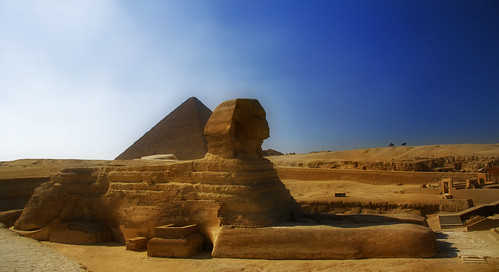 Now if the Sphinx is proven to be 7,000-10,000 years old, this posits a dilemma to Biblical chronology and the history of mankind. Because the time span from Adam-Eve to our present time is 6,000 years according to Biblical chronology, a 7,000-10,000 year old Sphinx implies that there were civilizations that existed before Adam and Eve, for which there is no scriptural support.
Now if the Sphinx is proven to be 7,000-10,000 years old, this posits a dilemma to Biblical chronology and the history of mankind. Because the time span from Adam-Eve to our present time is 6,000 years according to Biblical chronology, a 7,000-10,000 year old Sphinx implies that there were civilizations that existed before Adam and Eve, for which there is no scriptural support.Many think this would undermine Moses’ account of creation and the Bible. Yet it is quite obvious from Moses’ account that he left out many things, or they were not revealed unto him, such as dinosaurs and other animals that were extinct at the time of his vision 1490 years before the Messiah’s birth.
- How many times has Elohim created creations?
The greater question is NOT whether mankind’s Biblical chronology is just 6,000 years old, but if Elohim has created and destroyed life many times prior to Adam and Eve. Thus, could the new heaven and earth have been Adam’s and Eve’s appearance in a renovated earth (Rev. 21:1-4)? This would explain how the Sphinx can be a monument left over from a civilization and world prior to Adam and Eve.
When one looks at certain Biblical events in time, they seem to support the notion of Elohim creating and destroying life many times before creating Adam and Eve. For example, with Noah and the flood, one sees the earth’s population being destroyed and being repopulated by Noah and his offsprings. When Egypt was destroyed by plagues one can see it was repopulated and rebuilt. These are few instances of this principle being repeated over and over in time our creation.
- Were Adam and Eve first?
Now a belief in an Eternal Creator Yahweh-Elohim presupposed that Moses’ account of creation is NOT the first physical creation ever created. This would imply that Adam and Eve were not the first human creatures that Elohim created.
There is not enough information in the book of Genesis, to reach any decision on this. Yet there is scientific evidence which appears to prove that the earth and life upon it is more then 6,000 years old.
In an article in this issue of "PLIM REPORT," entitled "Elohim and the Ages," it shows that after a "week of ages" there is a always new order of things, meaning a new creation coming forth again. This article also shows that there are legends and myths in other cultures that state that mankind had been literally wiped out or destroyed many times before on the earth and repopulated by Elohim.
An examination of the Bible for Sphinx-like creatures might shed some light on the subject that many of the experts and researchers have overlooked.
- Does the Bible refer to the Sphinx?
Now there is no mention of the Sphinx in the Bible. Yet many visions from Elohim shown to the prophets of Israel reveal the principles of the design and the purpose of the Great Sphinx, as are confirmed in various legends and myths.
Both the Great Pyramid and the Sphinx are older than the Old Testament. What this means is that civilizations prior to Israel had physically documented what the prophets of Israel later saw and documented in their visions.
What this shows is that Elohim and His angels had always intercourse with mankind and the various civilizations throughout the ages. Elohim has never been absent from His creation. Now both Ezekiel the prophet and the Apostle John described something in their visions, which seems very similar to the Sphinx.
- Does John speak of sphinx-like creatures?
Now the Apostle John in Revelation wrote in the fourth chapter that he was in the Spirit on the Sabbath day. He states he saw a door in heaven open and Elohim sat upon His Throne (Rev. 4:1-2). There was a sea of glass before the throne (Rev. 4:6) and round about the throne there were four beasts. John describes them as follows. "And the first beast was like a lion, and the second beast like a calf, and the third beast had a face as a man, and the fourth beast was like a flying eagle. And the four beasts had each of them six wings about him; and they were full of eyes within: and they rest not day and night, saying, Holy, holy, holy, Lord God Almighty, which was, and is, and is to come (Rev 4:7-8)."
Now the beasts around the throne of Elohim in heaven are reflected in the form of the Great Sphinx and also the zodiac. Also these beasts around the Throne were guardians to the Throne of Elohim as the Great Sphinx was believed to guard the Great Pyramid. So, it appears that the Great Sphinx and the Great Pyramid are reflections of what is in Heaven.
- Did Ezekiel see Sphinx-like creatures in his vision?
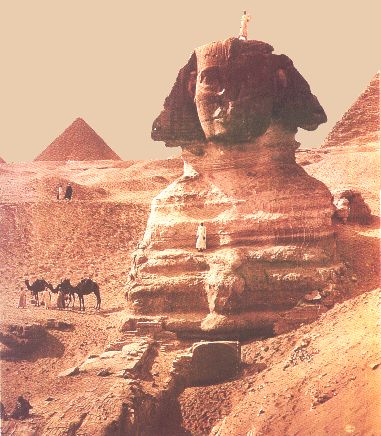 Now the prophet Ezekiel further confirmed what the Apostle John saw in his vision. He states that a fiery whirlwind cloud enfolding upon itself appeared unto him in a vision. He saw four creatures within this fiery cloud that had the appearance of a man. Now each one had four faces and wings (Ezk. 1:5-7). Each one of these creatures also had feet in the form of a calf.
Now the prophet Ezekiel further confirmed what the Apostle John saw in his vision. He states that a fiery whirlwind cloud enfolding upon itself appeared unto him in a vision. He saw four creatures within this fiery cloud that had the appearance of a man. Now each one had four faces and wings (Ezk. 1:5-7). Each one of these creatures also had feet in the form of a calf.Ezekiel described the four faces of the creatures that were below the Throne of Elohim (Ezk. 1:26-27) as follows. "As for the likeness of their faces, they four had the face of a man, and the face of a lion, on the right side: and they four had the face of an ox on the left side; they four also had the face of an eagle (Ezk. 1:10)." Thus, these four angelic creatures symbolically represent the whole angelic host that is around the Throne of Elohim. Thus, one can see the symbolic representation of the Great Sphinx in the earth-plane which many of the mystics wrote about concerning the Sphinx.
- Did Israel’s camp around the tabernacle mimic the Sphinx?
It also must be mentioned that the configuration of the 12 tribes of Israel around the tabernacle with three tribes on each side of the tabernacle reflects the 12 orders of angels (see illustration on p. 8). Each side represents a camp.
The camp of Judah, along with Issachar and Zebulun were on the east side facing the raising sun (Num. 2:3-9).
On the west side of the tabernacle was the camp of Ephraim, along with Manasseh and Benjamin (Num. 2:18-24).
On the north side of the tabernacle was the tribe of Dan along with Asher and Naphtali (Num. 2:25-31).
On the south side of the tabernacle was the camp of Rueben, along with Gad and Simeon.
The Bible verifies that the Great Sphinx was the result of someone having a great vision from Elohim who allowed a civilization to mimic the principles that were in heaven—as above so is below (Rom. 1:19-20). This is proven by the four cardinal points of the compass (North, South, East, West) and the fixed astrological signs of Aires, Capricorn, Libra, Gemini. These beasts around the throne of Elohim have great spiritual meaning but space will not allow an explanation of their significance. In future issues of the "PLIM REPORT" this topic will be discussed. ( Also see http://www.revealer.com/cherubim.htm)
- Conclusion
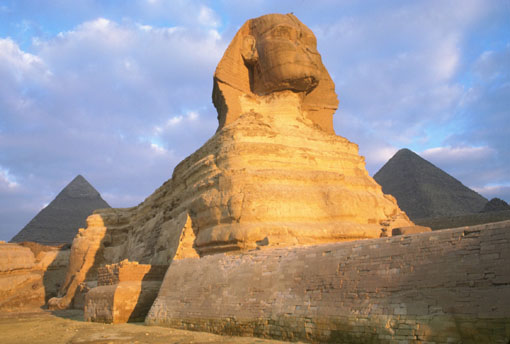 Our intent was not only to give the reader a brief history of the Sphinx, but also to show how new information challenges old theories. It also shows how little modern man knows about the history of this blue marble called earth. The Sphinx’s purpose was both symbolic and religious in nature.
Our intent was not only to give the reader a brief history of the Sphinx, but also to show how new information challenges old theories. It also shows how little modern man knows about the history of this blue marble called earth. The Sphinx’s purpose was both symbolic and religious in nature.Clearly, if the old model cannot explain anomalies, such as the Sphinx, then it has to be reevaluated in light of new information for this is the scientific method. Traditional thoughts of Egyptologists and flimsy evidence should not prevent us from considering new information with a new model.
The works of Graham Hancock, John West, Robert Bauval and others have definitely challenged the orthodox model of human history with proof that shows that previous civilizations had advanced knowledge that we are not privileged to today. The Sphinx, the Pyramid, Stonehenge, the drawing in the Nazcan plains of Peru, and other ancient sites throughout the world shows this. Mankind was much more advanced than the cave man, who supposedly began the history of man.
Finally, it must understood that the Sphinx appears to be similar to the creatures that surround the Throne of Elohim as the Apostle John and the prophet Ezekiel describe in their visions. What this shows is that Elohim revealed the image of the Sphinx to various civilizations prior to the prophets of Israel seeing it.
1 comment:
This is the first account of the Great Pyramid and the Great Sphinx that I have come across that seriously attempts to reconcile the scientific discoveries of Bauval and Hancock with the Biblical narrative. I find the Pyramid and Sphinx to be the two most wonderful and awe-inspiring things on Earth, and the more I research them, the more wonderful they seem. I think that they hold yet more secrets, and that what they finally reveal to us about our Creator and His hand in His Creation will prove to be bigger and more amazing than anyone has yet suggested. As above, so below; as in the distant past, so perhaps in the distant - or not-so-distant - future. Perhaps the plateau of Giza was once the Garden of Eden; and perhaps it may also be where the (pyramidal) New Jerusalem will one day come down from Heaven "as a bride adorned for her husband" (Revelation 21).
Post a Comment